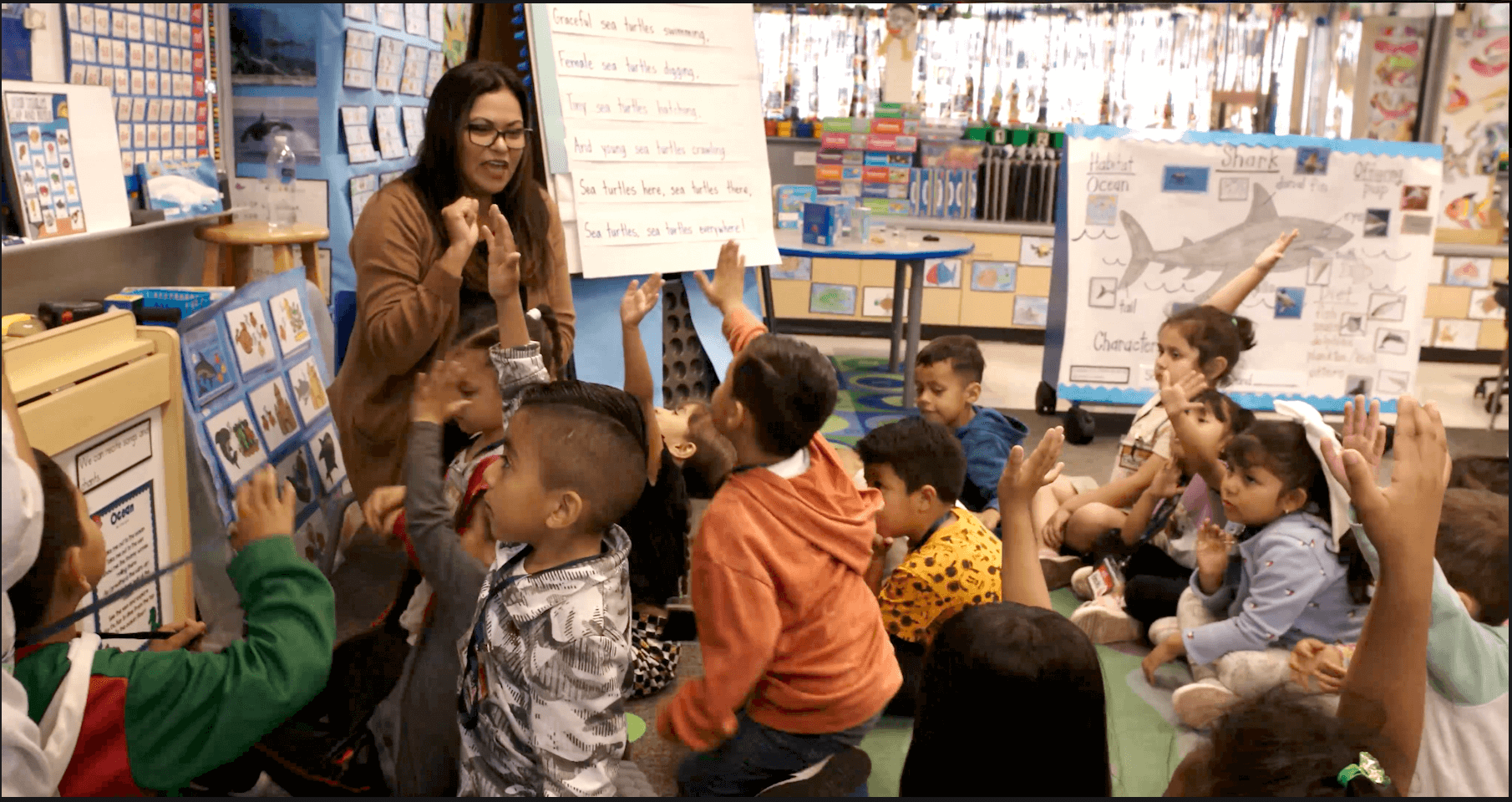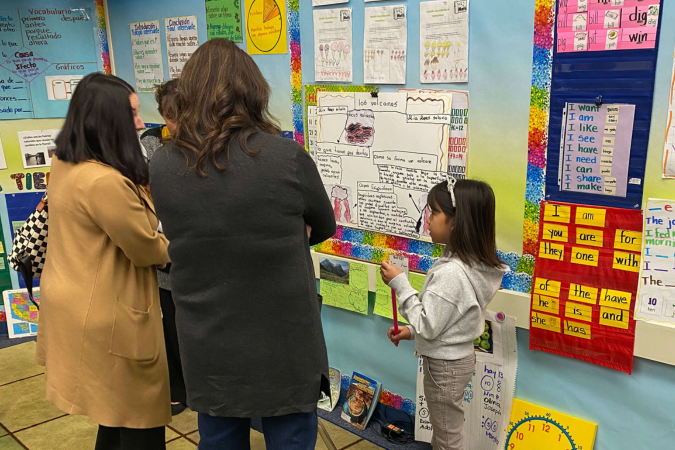
SEAL at the Reading League Summit
SEAL joined hundreds of experts, researchers, practitioners and neuroscientists for a first-ever Reading League summit to discuss important topics related to English Learners/Emergent Bilinguals (EL/EBs). The summit provided an opportunity for continued collaborative conversations on policy, neuroscience, foundational skills, and language development.
SEAL Senior Director of Research and Evaluation Dr. Martha Martinez and Early Learning Program Manager Patricia Montes Pate were among the national panelists who shared their work, research and best practices for supporting ELs/EBs.
Foundational Reading Skills Within a Comprehensive Literacy Program
With panelists from the University of Oregon and Stanford University and moderated by Dr. Antonio Fierro from Tools4Reading, Dr. Martinez’s panel session explored what the research says about foundational reading skills and pedagogical implications for teaching literacy skills in a linguistically diverse classroom. Dr. Martinez touched on the science around reading, learning and development, and the bilingual brain and offered recommendations.
“Teachers know just how dynamic and unpredictable a classroom environment can be and how important student motivation, prior knowledge, and social-emotional well-being are to the success of a given lesson. And, there’s been much research on the learning process,” said Dr. Martinez. "In addition, in the past few decades, considerable scientific advances have been made in understanding the bilingual brain. Bialystock’s research, in particular, has highlighted the advantages of bilingualism at various stages of human development and, importantly for [this particular topic], how both languages of a bilingual person’s linguistic repertoire are always active.”

Dr. Martinez argued for more research on biliteracy development and instruction that could build from the important research already done by Dr. Kathy Escamilla and her colleagues. She stressed the importance of bringing the reader into models of reading, as illustrated in the Active View of Reading model from Duke & Cartwright. She also emphasized the importance of bringing the science of learning and development into our understanding and application of reading research.
She shared the NASEM report, How People Learn II, noting that in the past several decades, there has been an explosion of research that has important implications for individual learning and schooling. This research highlights this complex interplay between the learner, educator, and the learning environment. On foundational skills, Dr. Martinez highlighted two recommendations from the 2016 IES Practice Guide which are not often included in the definitions of foundation skills:

- Teach academic language skills, including inferential and narrative language use and vocabulary knowledge
- Ensure students read connected text daily to support reading accuracy, fluency and comprehension.
She argued that these two recommendations are more challenging to teach and appear to be what EBs need. These recommendations call out the importance of providing students opportunities to use language for both inferential and narrative purposes, to read longer passages and providing choices in what they read.
Dr. Martinez notes that teachers need to build students’ background knowledge of concepts under study. Even in English-only contexts, teachers should leverage the home language to the greatest extent possible, including but not limited to encouraging families to continue using their home language.
“Within bilingual contexts, it’s important to teach metalinguistic awareness and to help students identify cross-language similarities and differences,” said Dr. Martinez. “And, it’s important to recognize that there is no need to teach foundational skills that transfer between the two languages, but it is very important to explicitly teach language irregularities within and across both languages.”
Dr. Martinez called attention to the federal Reading for Understanding Initiative, which funded six research projects over 10 years ago and was partly prompted by the fact that the previous $6 billion investment in Reading First had no significant effects on reading comprehension.
The National Academy of Education synthesized the major findings from the Reading for Understanding Initiative in a recent report, and she shared the major takeaways: that there are deep connections between knowledge, language and reading comprehension and that context is critical to our understanding of reading development because reading is a situated cultural activity.
She closed by noting that more research is needed specifically on biliteracy development for Emergent Bilinguals, especially within bilingual instructional contexts.“While Emergent Bilinguals were involved in many of the Reading for Understanding projects, the focus of the Initiative was on English instruction and English reading comprehension, and the authors specifically call out the need for more research on Emergent Bilinguals, stating, ‘More of our work on comprehension needs to be directed toward populations currently underserved in U.S. schools…. At the top of the list should be emergent bilingual learners’,” she closed.
To view Dr. Martinez’s visual presentation, click HERE. For more information, please contact us at info@SEAL.org
Developing Oral Language, Vocabulary, and Background Knowledge
https://youtu.be/QonwJ7tqCiUPate’s session discussion focused on the research base, benefits, and implications of developing oral language skills in more than one language and linking new learning to knowledge acquired in a student’s home language.
Joining panelists from Teacher PRO and Middle Tennessee State University and moderated by Dr. Magaly Lavadenz from Loyola Marymount University, Pate illustrated the sophisticated language of three- and four-year-olds and focused on the benefits of building oral language, vocabulary and background knowledge in a student’s home language.
Pate began with a discussion on Scarborough’s Reading Rope, one of two theoretical frameworks referenced in Reading League’s Defining Guide. Although, as she shared, Dr. Scarborough at the 2019 AIM Institute for Learning and Research noted that many factors influence reading and are missing from the rope, including children learning English as a second language.
She said that the rope speaks specifically to children developing literacy in their primary or home language, a critical component. She went on to say that by the time children enter school to learn to read, they have had five to seven years of being immersed in the language of hearing and producing sounds.

“In an English setting, this includes words like cat, hat, bat, so, the process of teaching these children to begin to read is relatively easier because we are building on the knowledge of the language they already have, such as the phonology, the semantics, and their background knowledge,” said Pate.“English learners will struggle with skills related to literacy. They will struggle with hearing and isolating sounds needed to decode text, recognizing vocabulary in print and experience difficulty with the structure and meaning of text.”
National research shows that one in 10 students come from homes where languages other than English are spoken, and despite reforms to strengthen literacy instruction, English learners continue to be underserved. On average, they perform below grade level, are twice as likely to drop out as their native English-speaking peers, and are less likely to attend a four-year college.
Pate stressed that ensuring these students are provided appropriate literacy instruction is both an equity and civil rights issue.Citing the National Literacy Panel and the NASEM report, Pate emphasized the role of home language and how findings show that literacy is best developed initially in the strongest language and benefits literacy in English.
“So, in working with English learners, it’s critical that we recognize that these children come to school with years of having built language in their home languages,” said Pate. “The degree to which we leverage that linguistic resource and build upon it to engage them in literacy and learning a new language is a major factor in their educational success.”
Pate said the National Committee for Effective Literacy released a paper describing the comprehensive and integrated literacy approach needed for English learners and takes dual language development and second language pedagogy into account. The approach integrates the four language domains and connects literacy development to language development and content knowledge overall.
“There are many other benefits of multilingualism,” said Pate, “These include higher levels of abstract thinking, increased high school graduation rates, more job opportunities and earning potential, a strong sense of identity and connection to family and culture. The benefits of building oral language, vocabulary and background knowledge in a student’s home language go beyond the work we do in our classroom. It has a tremendous impact on the lives of these children and our society.”
To view Patricia Montes Pate's presentation click HERE. For more information contact info@SEAL.org
Read More News from SEAL

Learn about changes in policy, up-to-date research, and unique practices to support Dual Language and Multilingual Learners. And don’t forget to sign up for our newsletter here.
%201.svg)


